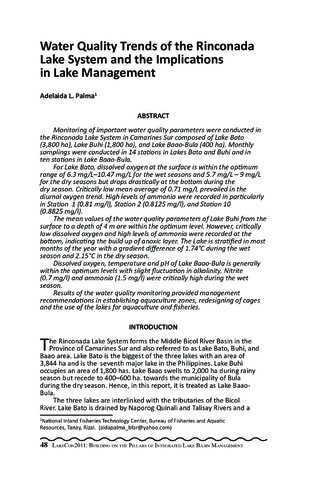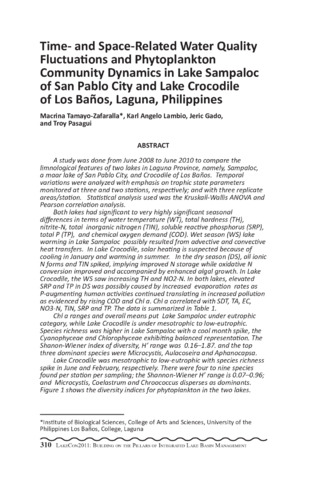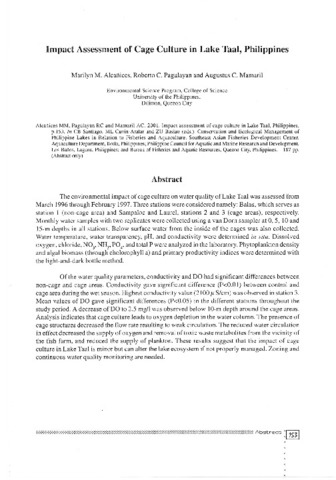Sustaining the resource use and management of Sampaloc Lake, San Pablo City, Philippines: A potable source of water
| dc.contributor.author | Jose, Aurora S. | |
| dc.contributor.editor | Cuvin-Aralar, Maria Lourdes | |
| dc.contributor.editor | Punongbayan, Raymundo S. | |
| dc.contributor.editor | Santos-Borja, Adelina | |
| dc.contributor.editor | Castillo, Lourdes V. | |
| dc.contributor.editor | Manalili, Eduardo V. | |
| dc.contributor.editor | Mendoza, Marlynn M. | |
| dc.date.accessioned | 2021-07-27T06:45:52Z | |
| dc.date.available | 2021-07-27T06:45:52Z | |
| dc.date.issued | 2005 | |
| dc.identifier.citation | Jose, A. S. (2005). Sustaining the resource use and management of Sampaloc Lake, San Pablo City, Philippines: A potable source of water. In M. L. Cuvin-Aralar, R. S. Punongbayan, A. Santos-Borja, L. V. Castillo, E. V. Manalili, & M. M. Mendoza (Eds.), Proceedings of the First National Congress on Philippine Lakes (pp. 171-178). Southeast Asian Regional Center for Graduate Study and Research in Agriculture (SEARCA). | en |
| dc.identifier.issn | 1656-8099 | |
| dc.identifier.uri | http://hdl.handle.net/10862/6135 | |
| dc.description.abstract | Water is the most basic and indispensable commodity. In the past, nobody realized the value of water until the wells and rivers started to dry. Of the numerous natural lakes of the Philippines (about 59), all are potential sources of surface water. The existing natural lakes are one of the best solutions to meet the water shortage of the different users and stakeholders. But human activities interfere with the natural life of these lakes, depleting its life-giving support characteristics, its productivity and usefulness. San Pablo City, situated in the apex of the heart-shaped Province of Laguna, is known as the City of Seven Lakes . Sampaloc Lake is the biggest, having a surface area of 104 ha. It is one of the ecotourism spots of the city and used to have an abundant supply of clear springs in the lakeshore area. This policy research study sought to address the question: What policies should be pursued to sustain the natural resources of Sampaloc Lake? There were several policy issues identified related to the sustainability, conservation and protection of the lake and its natural resources: (1) the capacity of the people in the lakeshore area to sustain the benefits and ecological balance; (2) enforcement of the regulations and laws to sustain the initiatives of the city government to rehabilitate, protect and conserve the natural resources of the lake; and (3) policy support for a relocation plan of the settlers within the lakeshore area. Major issues and concerns related to the lake were evaluated. First was the community-based approach in resource management and development. Second was the efficient delivery of services by the government, non-government organizations (NGOs), and other entities. Third was the synergy and complementation in the integration of policy interventions and initiatives of the city government and private sectors. Effectiveness, equity and distribution, and financial and institutional sustainability were the criteria used for the analysis in the policy research. Effectiveness was evaluated in terms of impact to poverty alleviation and lakeshore rehabilitation and protection, while equity and distribution were evaluated in terms of the quality of life of lakeshore-beneficiaries and settlers. Financial sustainability was measured in terms of the adequacy of funds to meet the financing obligations while institutional sustainability was evaluated in terms of whether the existing policy environment is favorable to supporting the proposed alternatives in response to Republic Act 7160, Local Government Code, Republic Act (RA) 8041, National Water Crisis Act of 1995, and RA 8550 and Fishery Code of 1998. | en |
| dc.language.iso | en | en |
| dc.publisher | Southeast Asian Regional Center for Graduate Study and Research in Agriculture (SEARCA) | en |
| dc.subject | Sampaloc Lake | en |
| dc.subject | Surface water supply | en |
| dc.subject | Policy research | en |
| dc.subject | Community-based resource management | en |
| dc.subject | Philippines | en |
| dc.title | Sustaining the resource use and management of Sampaloc Lake, San Pablo City, Philippines: A potable source of water | en |
| dc.type | Conference paper | en |
| dc.citation.spage | 171 | en |
| dc.citation.epage | 178 | en |
| dc.citation.conferenceTitle | Proceedings of the First National Congress on Philippine Lakes | en |
| dc.subject.asfa | surface water | en |
| dc.subject.asfa | drinking water | en |
| dc.subject.asfa | water | en |
| dc.subject.asfa | water quality | en |
| dc.subject.asfa | lakes | en |
| dc.subject.asfa | water pollution | en |
Files in this item
| Files | Size | Format | View |
|---|---|---|---|
|
There are no files associated with this item. |
|||
This item appears in the following Collection(s)
-
LakeCon2003 [49]
Proceedings of the First National Congress on Philippine Lakes



